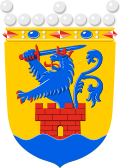Jacob De la Gardie
This article needs additional citations for verification. (June 2019) |
Count Jacob De la Gardie | |
|---|---|
Governor-General of Swedish Livonia | |
| In office 1622–1628 | |
| Succeeded by | Johan Skytte |
| Personal details | |
| Born | 20 June 1583 Swedish Estonia |
| Died | 22 August 1652 (aged 69) Stockholm, Sweden |
| Spouse(s) | Ebba Brahe (m. 1618–52; his death) |
| Children | 14, including: Magnus Gabriel De la Gardie Maria Sofia De la Gardie Axel Julius De la Gardie |
| Residence(s) | Makalös Palace, Stockholm Läckö Castle |
Field Marshal and Count Jacob Pontusson De la Gardie (
He was
Biography
Antoine Marie Jacob
As a young adult, De la Gardie was held prisoner in the
Prelude to Jacob de La Gardie Campaign
The
Despite this, Russia's instability continued to the near-total
Execution of the campaign
In 1608–1613, De la Gardie as Sweden's Chief Commander in Finland also commanded the Swedish war efforts in Russia. Thus, in accordance with the Swedish-Russian military alliance formed in 1609, he together with Evert Horn now took charge of providing an auxiliary corps to support the Russian forces commanded by Mikhail Skopin-Shuisky.[3]
Although officially the Swedish-Russian alliance was not ratified before July 1609, already in the early spring of 1609 Sweden gathered for this mission to the city of
A combined Russo-Swedish army of about 10,000 soldiers set out from
In June 1610, De la Gardie and Prince
Ingrian War (1610–1617)
Not long thereafter, the Ingrian War in 1610–1617 between Sweden and Russia was initiated, during which De la Gardie played a significant role militarily. A new army was rapidly being formed for Jacob De la Gardie, again stationed in Viborg. It this time included four foreign mercenary fighting units, in addition to Finns and Swedes (seven cavalry and two infantry units arrived from Stockholm to Turku on 25 January 1611).[6]
De la Gardie also claimed that Sweden should take advantage of the ongoing turmoil in Russia, later known as the
In 1617, De la Gardie became the chief Swedish negotiator at the Treaty of Stolbovo that ended the Ingrian War, whereby the Swedish Empire was able to secure important territorial concessions from Russia, effectively closing off Russia from access to the Baltic Sea.
From July 1619 to 1622, De la Gardie was Governor of the
After 1621, De la Gardie took part in the
Member of the Privy Council


De la Gardie became a member of the Swedish Privy Council in 1613. In 1620, he became Lord High Constable and, as such, he was later one of the five regents ruling Sweden during Queen Christina's minority (1632–44). His pacifist and pro-French and pro-Polish attitudes often put him at odds with Chancellor Axel Oxenstierna, who led Sweden's war effort in the Thirty Years' War after the death of Gustavus Adolphus in 1632.
As De la Gardie supported many of Oxenstierna's other policies, eventually the two leaders reconciled after Oxenstierna's return to Sweden in 1636. Although the Marshal's Office came under criticism that year, De la Gardie continued to operate effectively, making large profits from leasing royal revenues and from loans to the crown.
Family life
In 1618, De la Gardie married Ebba Brahe, the love of young Gustavus Adolphus. The couple had 14 children, the most famous among them being Magnus Gabriel De la Gardie, Maria Sofia De la Gardie, Axel Julius De la Gardie and Countess Christina Catharine De la Gardie (1632–1704), who married Gustaf Otto Stenbock and was mother of Magnus Stenbock.
Death and legacy

Count Jacob De la Gardie died in Stockholm in 1652 and is buried in the Veckholm Church in Uppsala County, Sweden. The town of Jakobstad in Finland is named after him. A shopping mall in Old Tallinn is named De la Gardie in honor of him. During the Ingrian War, the Finnish soldiers nicknamed their commander Laiska-Jaakko ("Lazy Jacob"), due to the unusually lengthy six-year occupation of Novgorod. This name is still widely remembered in Finland. The siege was thus recorded in a folk verse: Lähti suvi, lähti talvi, vaan ei lähde Laiska-Jaakko. ("The summer left, the winter left, but Lazy Jacob does not leave.")
References
- ^ Vilhelm Fredrik Palmblad (1838): Biographiskt Lexicon öfver namnkunnige Svenska Män 4, D – Fl; Upsala, pages 83–97.
- ^ ISBN 978-91-7263-790-0.
- ^ OCLC 620935678.
- ISBN 0-304-36373-1
- ISBN 91-85057-47-9, LIBRIS-id: 9501098.
- ^ a b c Petander C-B (1964): J. Anteckningar om österbottniskt fotfolk före år 1625, Vasa, Österbotten.
- )
- ISBN 978-91-7263-790-0.
- ISBN 0271024658.
External links
 Media related to Jakob Pontusson De la Gardie (1583-1652) at Wikimedia Commons
Media related to Jakob Pontusson De la Gardie (1583-1652) at Wikimedia Commons- Läckö Castle (The castle of Magnus Gabriel De la Gardie) at Statens fastighetsverk
- Jacob De la Gardie (1583-1652) Archived 3 March 2016 at the Wayback Machine Image at heninen.net
- Jaakkima - Lahdenpohja at heninen.net
- "Jakob De la Gardie". Svenska litteratursällskapet i Finland. urn:NBN:fi:sls-4102-1416928956708.

